Chickweed definitely signals our winter foraging season. I had a private class in Jacksonville last Friday. While demonstrating some Pellitory — another cool-weather edible — I saw some young chickweed. That’s 150 miles north of where I live so it still might be a few weeks before it pops up mid-state. I’ve never found it in south Florida even in the coolest months.
Chickweed is easy to identify and one can find virtually hundreds of recipes on the Internet on how to use it, both as food and medicine. It has a single line of hair that changes stalk sides at every pair of leaves, the stem has a stretchy inner core, the blossom looks like it has 10 petals but really are only five, and it tastes like raw corn or corn silk. To read more about Chickweed go here.
Squirrels do not know they don’t like pomegranates. A squirrel will see one, think “WOW!” and take a bite or two then throw it away. The light yellow pith of the pomegranate is too bitter for squirrels to eat. Unfortunately, the same squirrel the next day will see a pomegranate and think “WOW!” and will destroy another one, and the next day another one and so forth. To grow pomegranates you have to control your local squirrels either by trapping and releasing elsewhere or trapping and into the Brunswick Stew pot.
I was close to 60 or so when I learned some people don’t eat pomegranate seeds. They eat the red arils and not the seeds. I grew up in a family that ate arils and seeds. Many years ago I added eating the pomegranate skin as well, with preparation of course. Why eat pomegranate peelings?
While the fruit of the pomegranate is healthy the skin can have literally 10 times the good stuff. Pomegranate peelings are loaded with antioxidants particularly to reduce the oxidation of LDL cholesterol which if left uncheck can hardening of the arteries. These anti-oxidants include lavonoids, phenolics, proanythocyanidins and punicalagin. They are also packed with vitamin C. Oil in the skins help reverse and prevent skin damage and the oil is strongly anti-inflammatory. The skin can be half the dry weight of the entire fruit and contains tannins, potassium, calcium, phosphorus, magnesium and polysaccharides which might stimulate your immune system. The fruit’s ellagitannins shows anti-prostate cancer activity.
My preferred way to consume the pomegranate peelings is as a tea. I clean them using a fillet knife to slice off all the bitter yellow material. Then I dry the red peelings in sun light to avoid any degradation by dehydrator heat. I use one part peeling (whole or powder) to 20 parts water. That’s about half an ounce to a cup of water. Seep it like you would regular tea.
Incidentally if you feed the pomegranate peelings to your food animals their meat will have more anti-oxidants in it. You can read a little more about pomegranates from a newsletter five years ago.
It was perhaps a very hungry or disparate man who first ate an oyster raw, or pine needles. Oysters have an image problem. With conifers it is taste. All of those wintergreen evergreens have strong flavors caused by various oils and other chemicals. Man has used them from food to entertainment to medicine. The entire group does not get a pass, however. Podocarpus and Yews are two common relatives that can range from mildly toxic to deadly. Also intentional concentrations of various chemicals from even user-friendly species can be unhealthy. The Ponderosa Pine is also dangerous to livestock. But the right species as a tea, flavoring or syrup has been used for as long as man has been hungry, or ill.
Pine needle tea (from any Pinus) is probably amongst the best known conifer use though “spruce gum” was more popular for a while. What the tea, and the gum provide, are anti-oxidants and polyprenols which work in very different ways. Our metabolic systems produces free radicals, which are molecular thieves. They can get the molecule from our body or from any number of anti-oxidants that easily supply that extra molecule. As an anti-oxidant vitamin C is damage control. This is on a small level and happens perhaps billions of times per second. But over time those little injuries build up eventually causing this or that DNA to mutate or dysregulate which can be a state leading to cancer. Polyprenoles work in a very different way. They stress the body, like lifting weights, and make it stronger, in this case usually the immune system. The larger concept is called hormesis, exposure to this or that in very small amounts which in larger amount could be lethal. Green tea , for example, is in that category. People who drink green tea regularly on average live longer and have less disease than those who do not drink green tea. The constant low-level challenges to the body make it slightly stronger. One good thing about pine needle tea is that it offers both protections.
You will also read on the informational junk yard called the internet that pine needle tea causes abortions. In normal use and normal concentrations that simply is not true. Most of that exaggeration from an animal study in which cattle were given huge amounts of dry, Ponderosa Pine needles. That did cause them to have an increase in still births and abortions. But the amounts were huge, and, cattle have multi-chambered stomach thus things stay around much longer than in the human system and that can make a difference as well. I note the Greeks have been drinking “Retsina” which is pine flavored wine, for thousands of years. It produces only the usual expected effects.
Depending on the study conifers can fight viral infections, reduce inflammation, cut triglycerides, spur the immune system into action, provide several vitamins, and clear the lungs. And if you include Spruce Gum, you can add exercise to the list. It takes a lot of chomping to get a hunk of spruce resin into a small piece of pliable gum. Been there. Chewed that.
Besides the needles, young cones can be steamed, the cambium is also edible, and the pollen can give a testosterone-like boost. To read more about the pines go here.
I mentioned making mustard in one of my classes and was asked to include it in a newsletter. I make about half a gallon at at time but it tastes so good it goes fast. Here is the basic ingredient list: One cup each: Mustard seeds, Water, Balsamic Vinegar, Chardonnay Wine. (I prefer non-oaked Chardonnay but oaked is okay, and any vinegar will do. Some like Tarragon vinegar.) Also add two teaspoons of turmeric per each cup of seeds. I usually make a double batch so that will use up most of a bottle of Chardonnay as it is not a wine I like to drink. I also cut back on the water a little when making a large amount. While you can buy mustard seeds from spice boutiques you can also buy them for considerably less at Indian spice stores. Or, you can collect your own mustard seeds. Radish seeds work equally well. Do not use seed for planting as they usually have been treated. Also the vinegar you choose will not only impart a particular flavor but bite as well. Balsamic vinegar is more mellow than distilled white vinegar. Which to use depends on personal preference.
All of the ingredients go into a large, covered jar which you allow to sit for a few days to a week. Then you separate the (now) swollen seeds from the liquid. Reserve the liquid. While you can mash the seeds by hand a food processor makes it much easier and quicker. I grind the seeds into a thick paste while adding, a little at a time, some of the liquid. The goal is to pulverize the seeds and get the consistency you like. Near the end of that process you can add optional things to flavor the mustard such as salt, honey, onion or garlic powder. I often separate out a cup of the basic blend and add some honey to it for a friend who prefers that flavor.
It can be consumed immediately and gets tastier the longer it sits in the refrigerator.
Foraging Classes:
Sunday, Nov. 29th, Florida State College, south campus, 11901 Beach Blvd., Jacksonville, 32246, 9 a.m. As this is a holiday weekend I do not know of the college bathrooms will be open.
Sunday, Dec. 13, Mead Garden,1500 S. Denning Dr., Winter Park, FL 32789, 9 a.m.
Sunday, Dec. 20th, Dreher Park, 1200 Southern Blvd., West Palm Beach, 33405, 9 a.m.
Sunday, January 17th, 2016, Sunday, Nov. 15, Mead Garden,1500 S. Denning Dr., Winter Park, FL 32789, 9 a.m.
To learn more about the classes go here.
Want to identify a plant? Perhaps you’re looking for a foraging reference? You might have a UFO, an Unidentified Flowering Object, you want identified. On the Green Deane Forum we — including Green Deane and others from around the world — chat about foraging all year. And it’s not just about warm-weather plants or just North American flora. Many nations share common weeds so there’s a lot to talk about. There’s also more than weeds. The reference section has information for foraging around the world. There are also articles on food preservation, and forgotten skills from making bows to fermenting food. Recent topics include: Chinese Lanterns Edible? Blue Mist Flower, Two Leaf Nightshade Puzzle, Some Type of Olive? Cultivating Hopniss California Wild Mushroom Parties, A Good Reason To Eat Wild Garlic, Black Walnuts and Amaranth, Sea Salt and Plastic, Wild Mustard? Heavy Metals. Oriental Persimmons. What is it? Pine Cough Drops and Needles, Skullcap, and Malodorous Plant? You can join the forum by clicking on the button on the upper right hand side of this page.
All of Green Deane’s videos are available for free on You Tube. They do have ads on them so every time you watch a Green Deane video I get a quarter of one cent. Four views, one cent. Not exactly a large money-maker but it helps pays for the newsletter. If you want to see the videos without ads and some in slightly better quality you can order the DVD set. It is nine DVDs with 15 videos on each. Many people want their own copy of the videos or they have a slow service and its easier to order then to watch them on-line. They make a good Christmas or birthday gift. Individual videos can also be ordered. You can order them by clicking on the button on the top right of this page or you can go here.
This is newsletter 184.
To donate to the Green Deane Newsletter click here.

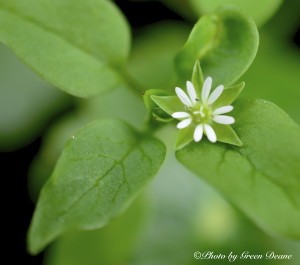
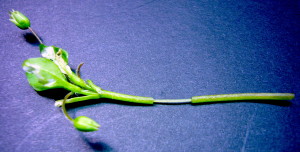
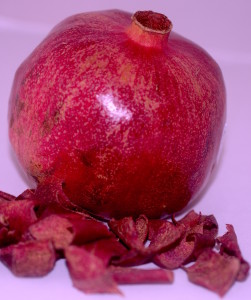
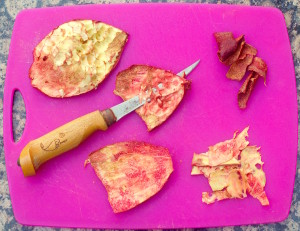
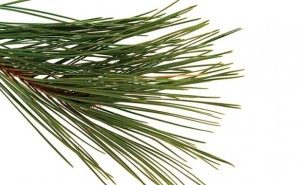
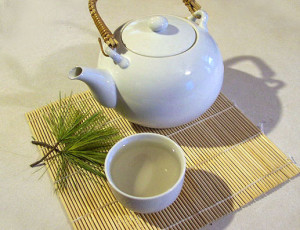
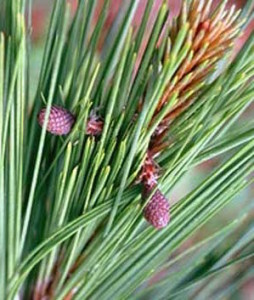
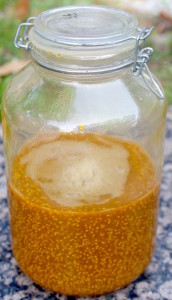
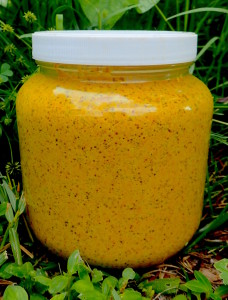
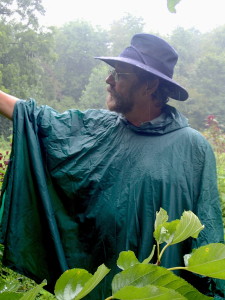
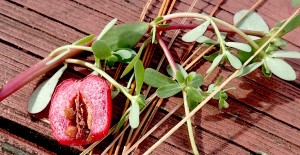
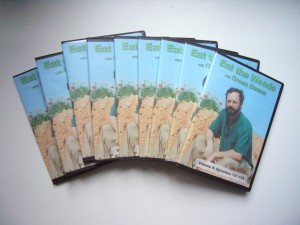

My father lived the last years of his life just west of the Orlando area and was an avid gardner and outdoorsman. He enjoyred sprouting unusual fruits and vegetables and grew kiwi, chinquapins, pomagranates, and many others. He lived in an urban environment with neighbors close by and squrrels which grew to be his nemesis. He grew a dozen pomagranates along the fence and harvested a great deal of fruit, that is all he could save from the squirrels. His complaint, like yours, was the bushy tails biting a couple of holes in the fruit and then discarding them. The fruit would eventually rot and fall off the tree and if not raked up into the compost pile the sqirrels would eventually come back to the dried shell, peal the seeds out and eat them. They don’t like the flesh but love the dried seeds. Dad had a pellet rifle and harvested many of the squirrels so didn’t mind losing a few fruit of various kinds to fatten the herd. I will be making my trditional pomagranate dressing for Thanksgiving (with the seeds). Happy holiday!
I don’t even remember how the tradition got started, but with my birthday being around Thanksgiving, I always got a pomegranate, so have always had a special affinity for them. Cool to know there are benefits in even the peels! Thanks!
Growing up in Maine they were a seasonal fruit in the grocery store. Small, hard, expensive. We did not eat many but I got to like them.
Depending on the main three characteristics approved by you, I welcomed the chickweed under an old oak tree during my visit to Southampton (UK) two years ago. Certainly it was; from there to the kitchen to end with a sumptuous meal. I wished to repeat the experience back home – Sudan , bought some seeds and tried to grow the plant under best possible conditions; but it kept telling me that was not its place.
I like very much the diamond like “ seeds with arils” of pomegranate. I eat them whole when fresh and prefer eating them dried – almost like sultanas. It takes a long time for the fruit to ripen. It is recommended to pat the fruit using the finger to hear a metallic sound as a signal for ripening. I’m growing many pomegranate plants some of which in large pots; but those rooting directly in earth are more prolific. However, I suffer from flowers not holding firmly to mothers even in absence of wind. As to pollination some people advise to use a soft brush as a carrier of pollen from male to female flower. In my case till now (two years after planting) it is not clear to differentiate between the two.